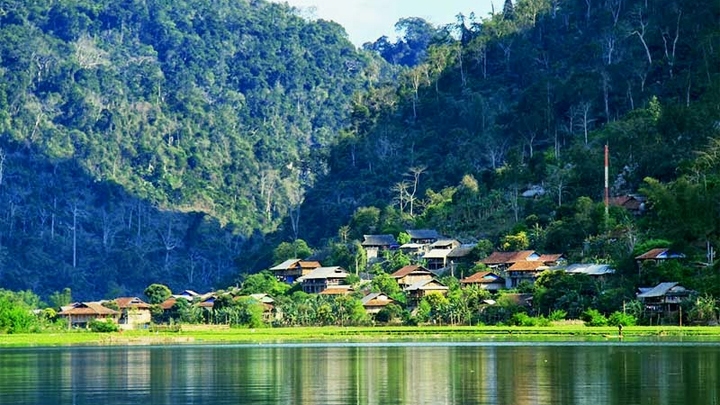Over recent years, traditional stilt houses in Tay ethnic villages have been renovated and upgraded to provide homestay tourism services for visitors to Ba Be lake in Bac Can province. Homestay tourism has not only helped local Tay people to escape poverty but also provides visitors with an opportunity to explore the best of land, life and indigenous culture around the lake.

A picturesque panorama of stilt houses leaning against the mountain in Pac Ngoi village. (Photo credit: Hung Nguyen Quoc)
A good way to boost locals’ incomes
Taking a boat ride to Pac Ngoi village in Nam Mau commune of Ba Be district, visitors can admire a picturesque panorama of more than 90 stilt houses leaning against the mountain.
“Pac Ngoi” in Tay ethnic language means a hundred of arroyos. Elders in the village say that the Leng river, starting from a mountain range in Bang Phuc commune, Cho Don district, pours water into Ba Be lake. In the olden days, people lived in the mountain, after years, the Leng river created alluvium flats, they moved down from the mountain to establish Pac Ngoi village.
More than ten years ago, Ngon Khanh Toan was the first Pac Ngoi villager to renovate and remodel his house to provide a homestay service, which attracted a large number of visitors and brought in a generous source of income. Toan has set an example for the other 29 households there to follow.
All homestay facilities in the village are wooden houses equipped with the necessary amenities. The owners of the houses also provide food and drink service, bike renting, trekking, and art performances for backpackers.
Dong Van Ut struggled to manage his living when he had to live on the income from farming in the past. Things didn’t improve until 2015 when he got a loan to expand and upgrade his house for homestay tourism. During daytime, family members go to the field and do farm work, and return home in the evening to cook traditional dishes for visitors.
With nine rooms, most of them being booked by foreign tourists, his family can earn approximately VND100 million a year, and their living conditions have been significantly improved.
The Sang hostel by Dam Thi Mien is one of most-visited homestays in Pac Ngoi village. Located close to Leng River, the homestay offers a tranquil view over the river, where children joyfully play with water in the evening and smoke drifts from houses’ chimneys.
Since 2009, Mien’s hostel has accommodated roughly 500-600 international tourists annually, generating a net revenue of more than VND100 million. Mien said that foreigners have also helped her improve her speaking and communication skills in English.
Further vision to foster tourism
Tay ethic women performing folk Then singing, which is accompanied with tunes played on the Tinh gourd lute
When the darkness of night falls upon the sky, members of the village’s art troupes dressed in their traditional costumes entertain visitors with beautiful melodies of folk Then singing, which is accompanied with tunes played on the Tinh gourd lute. Four art troupes have been set up in the village, with members being local women.
Hoang Van Chuyen, head of Pac Ngoi village, said that each homestay facility there can accommodate from 10 to 20 rooms in a total area of around 200 square metres each. There is no competition in price among the facilities, with prices set at VND70,000 per person per night.
Over recent years, training courses have opened for villagers, helping visitors improve their business skills and share experience in bettering their tourist services.
According to travel agents, the pristine beauty of the natural landscape, superb indigenous food, and hospitality of locals have attracted foreigners to Pac Ngoi. Many of them have returned to the village many times, bringing their friends and family with them.
Many homestay hosts have become aware of the importance of marketing their products to customers. So far, seven households in Pac Ngoi have run their marketing programmes on the internet. Dong Van Ut recently invested nearly VND6 million in such a programme. Since his hostel is available in booking.com and facebook, the number of visitors has increased considerably.
According to Bac Can Provincial Department of Culture, Sports and Tourism, Tay ethnic people’s homestays have become a highlight in the province’s ecotourism. The model has been expanded to neighbouring villages of Bo Lu and Coc Toc.
In a vision to develop sustainable tourism, Back Can provincial authorities have taken measures to improve the traffic infrastructure, design new adventure tours to discover Tham Khit and Pham Phay caves, and work out a proper plan for homestay accommodations in the locality.
Thanks to homestay tourism, ethnic Tay people living around Ba Be lake have been offered a chance to escape poverty and improve their livelihood, making their villages become more attractive on the travel map of international visitors.

















